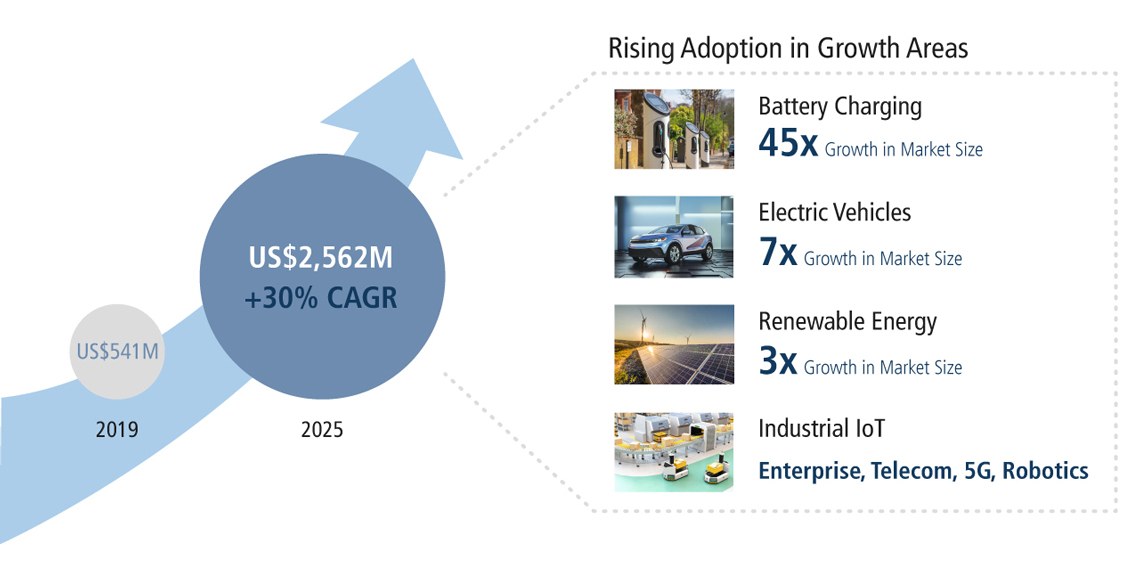Fast-Growing Silicon Carbide Market
Source: Yole Development, 2020.
Inflation is at a 40-year high, and anyone who owns an automobile definitely will have felt the pinch at the gas pump. With oil prices up >50% compared to a year ago, you may be thinking about switching to an electric car to save money. Turns out you’re not alone. Online searches for new and used electric vehicles (EV) more than doubled in the two weeks following Russia’s invasion of Ukraine. And with the growing number of models available in the market, it’s not hard to see why. EVs are already cheaper than gasoline-based cars due to lower maintenance and fuel costs. Current elevated oil prices only look to accelerate the transition to renewable energy and EVs.
Automakers are racing to ditch internal combustion engines in lieu of cleaner and more efficient EVs. At the heart of this monumental change are power semiconductors, which themselves are undergoing a sea-change as the industry begins to orchestrate a shift from pure silicon to silicon carbide (SiC). SiC is a compound semiconductor technology that enables better energy efficiency compared to pure silicon. In EVs, this means smaller batteries, longer driving distances, faster charging and lower cost—ultimately paving the way for increased EV adoption. SiC is also starting to touch a multitude of industries, and is quickly emerging as a key material for a sustainable and connected future.
Everything that uses power can always be more efficient, and SiC will help especially for large-scale or high-voltage applications such as data centres, industrial equipment, power grid and solar/wind power, where minimizing energy loss is key. SiC is also found in 5G base stations as the technology is used for high-power radio frequency power amplifiers. Whether it be for power or connectivity, 5G needs SiC, and we expect SiC will be ubiquitous in the future, especially within industrial IoT, for robots, EVs, energy storage, charging stations, high-speed trains and the overall network that connects them.
SiC’s ability to operate at high power and voltage settings allows for a significant reduction in chip area and simplified chip design. Meanwhile, operating temperatures as high as 200°C help reduce cooling requirements, ultimately allowing for more a compact and robust solution. It is thus unsurprising that the SiC market is projected to grow at a fast pace, from US$541m in 2019 to US$2.56bn in 2025, implying a 30% CAGR. As good as this all sounds, SiC is expensive and not easy to make. Infineon, ST Microelectronics, and Rohm are some of the very few companies globally that can make SiC and Gallium Nitride on SiC. Of these, we believe Wolfspeed is one of the best positioned given its SiC technology leadership, strong customer base and pre-emptive capacity expansion plans.
Advantages of Silicon Carbide (SiC)
Source: Wolfspeed.
Wolfspeed
Wolfspeed is a world-leading innovator and manufacturer of silicon carbide (SiC) and gallium nitride (GaN) based in the U.S. Its materials and devices are used for high power and radio frequency (RF) applications that include communications, aerospace, defense, industrial, energy, and transportation. Previously known as Cree, Wolfspeed was the first to commercialize SiC technology in the world, and has maintained its leadership for the past 30 years.
Wolfspeed boasts the largest SiC wafer capacity in the world, with over 60% share. Order visibility is high given numerous long-term wafer supply agreements and strong relationships with customers like ST Microelectronics, Infineon, Nokia and Ericsson. Wolfspeed also supplies SiC power devices, and boasts a strong Automotive is a growing area where Wolfspeed partners with several leading automakers like General Motors and Volkswagen, and is particularly excited about the growing auto content opportunity.
Wolfspeed targets 2024 revenue of $1.5bn, representing a +40% CAGR from 2021.Over the next few years, Wolfspeed will be focused on driving SiC manufacturing costs down by focusing on yield and lower cycle times. The company is currently building the world’s largest silicon carbide fabrication facility in upstate New York, which will be fully automated. We are positive on Wolfspeed’s position and profitability expansion over the next few years, as we think the improved scale and shift to large 200mm wafers should help to continue to widen the cost & technology gap with competitors, and help the company remain at the forefront of driving the SiC revolution across EVs, 5G and industrial IoT.
Wolfspeed: Global Leader in Power Semiconductors
Source: Wolfspeed.







